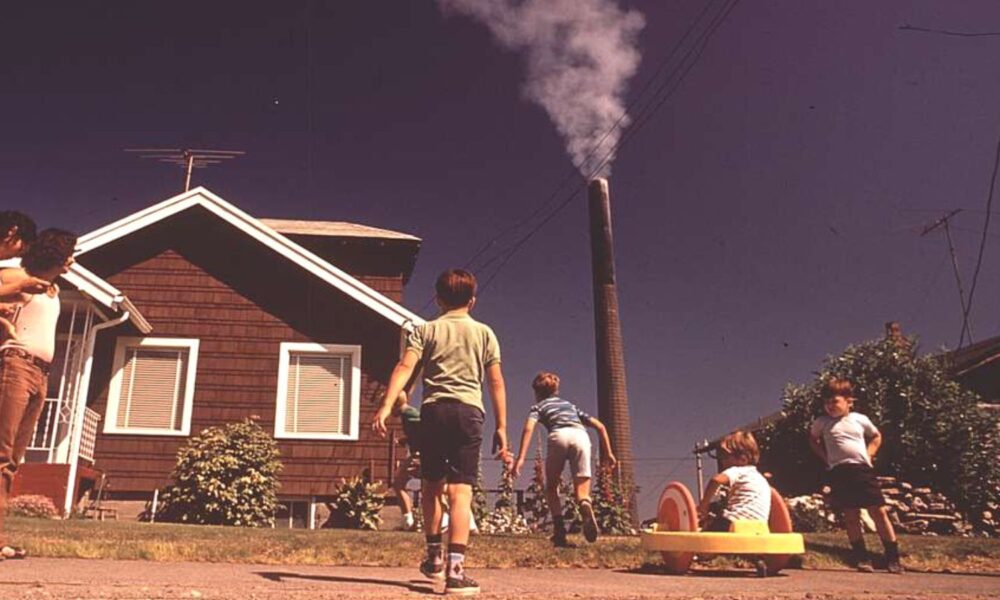There is a growing body of science to support the need to address the harms from exposures to multiple pollutants from multiple sources that accumulate over time, especially in environmental justice communities. Some of these scientific studies also can inform how cumulative impacts to pollution could be addressed. Here’s what you need to know:
People are exposed to multiple chemicals
Exposure science is the study of how, and to what extent, humans come into contact with environmental factors, including chemicals. Scientists measure exposures with tools like air sensors and silicone wrist bands, among other methods. An individual’s chemical exposures over the course of a lifetime is called the “exposome.” Multiple chemicals and compounds can be measured in individuals as biomarkers that change over the course of their lives. There are detectable levels of many different chemicals in the US population from environmental exposures. Chemicals exit and enter the body at different rates, depending on their chemistry and biochemistry. Chemicals that accumulate in the human body and are “stored” have been measured in 99 to 100 percent of a representative sample of US pregnant women.
Exposures occur via different pathways
Exposure scientists have documented that people come into contact with environmental chemicals through contact with skin, ingestion, and breathing, and a combination of all of these and they have been able to better understand these pathways. By incorporating the principles of environmental justice into exposure studies, for instance, scientists and communities have been able to transform the issue of pesticide exposure among the children of farmworkers from a shared community narrative into what is now widely recognized and understood as the “take-home” exposure pathway.
Pollution is not equally distributed
Scientific studies that analyze the geography of pollution sources and people, using data from the United States Census, have shown over and over again that pollution is not equally distributed geographically or in the US population. More often than not, a higher pollution burden has been measured and modeled in BIPOC and low-income populations. In the United States, more than half of the people who live within 3 kilometers of a hazardous waste facility are people of color. Moreover, scientists have found that when there is more racial residential segregation, the pollution exposure disparities are more extreme.
Some environmental chemicals have similar chemistry and biological effects
Anyone who studies chemistry quickly learns about the fascinating shapes and properties of chemical compounds. These features partly determine how chemicals interact in the human body, whether and where they accumulate (i.e. in bones, teeth, blood, fat, etc.), and how they interact with human biomolecules, cells, and systems. Some chemical compounds are similar to one another in whether and how they make functional or anatomical changes in the human body—called their mode of action. A growing body of scientific evidence supports regulating chemicals with similar structures, functions, and impacts as a chemical class rather than one pollutant at a time. For example, many per- and polyfluoroalkyl substances (PFAS) are well suited to this approach due to their similar properties.
Exposure to mixtures can be worse than exposure to single chemicals
Many scientists have found that doses of multiple chemicals can have different and sometimes greater adverse impacts than doses of individual chemicals alone (some examples include studies on: endocrine disrupters, carcinogenic impacts, and neurodevelopment). Today in the United States, chemicals are normally regulated by comparing an individual chemical exposure to a level that has been found to have little to no impact within a margin of safety, such as a “No Observed Adverse Effect Level.” But, there is evidence showing that exposure to multiple chemicals—all individually beneath these threshholds—can have an overall impact greater than what would be expected in an additive response. Evidence of this has been found in animal models for mixtures of chemicals with and without similar modes of action. This is particularly important for pesticides since active ingredients are regulated while so-called “inert ingredients” are normally not. This is still the case even when the toxicity of the active ingredients has been shown to differ from the pesticide product formulation.
Chronic stress and social adversity can worsen outcomes from chemical exposures
Humans vary in how they are impacted by chemical exposures. This variability can be driven by both intrinsic and extrinsic factors. Regulatory risk assessments that inform chemical regulations are sometimes required to account for human variability (hazardous air pollutants, for example). But these assessments predominantly account for intrinsic factors such as pre-existing conditions and people’s age, or “lifestage.”
And yet, we know that people are exposed to chemicals and to negative experiences or stressors that aren’t chemicals. A growing body of research is investigating whether populations have different outcomes from the same exposure due to inequitable or racist structures and systems that specifically harm people of color and people with low incomes. There is some evidence that populations with adverse social conditions have worse outcomes or longer recoveries from environmental chemical exposures. As an example, people exposed to air pollution related to chemicals released from combustion of fossil fuels, called polycyclic aromatic hydrocarbons (PAHs), and also experiencing higher levels of material hardship, had higher rates of Attention Deficit/Hyperactivity Disorder (ADHD). In another study, early life exposure to lead had a higher association with school suspensions for African American students than it did for their white counterparts. In other words, chemical exposures together with psycho-social stress, socio-economic status, noise, racial disparities, and lifetime trauma among other factors, have been associated with worse health outcomes compared to chemical exposures alone. There is scientific support and existing methodologies for taking real-life human variability into account in assessing effects from multiple environmental, social, and economic stressors.
Aggregated environmental data are associated with adverse health outcomes
Today, there is an abundance of modeled and measured environmental data, and these metrics can be summarized across geographies for spatial comparisons. Some agencies, research institutions, and nonprofit organizations further combine geographically aggregated environmental and public health stressors into a single estimate of burden, or a cumulative index. Since these cumulative indices are aggregated over a county, census tract, or block group, they can be spatially analyzed to compare different areas, and are used to prioritize work and resources; in New Jersey, they will even be used to condition or deny permits. Some of these geographically aggregated combinations of environmental and public health stressors have been found to be associated with neurodevelopmental health outcomes, and asthma.
Lived experience offers valid, meaningful data
To provide more health-protective regulations and decrease disproportionate impacts, assessments of cumulative impacts will need to include consideration of non-chemical stressors such as measures of social adversity. It will also be necessary to take into account people’s lived experience. By incorporating qualitative data, we can often help gain understanding that quantitative approaches cannot fully capture.
Quantitative approaches are good at providing information about the magnitude and pervasiveness of known phenomena. But qualitative approaches can elucidate previously unknown information and provide meaning and understanding of phenomena. Mixed methods are the structured and intentional integration of these two approaches. Mixed methods approaches have evolved over the past several decades and have strengths in bringing in lived experience to address research questions, similar to public comments on analyses that inform a regulatory decision. Social science fields have a long history of conducting analyses on results from semi-structured surveys to answer research questions.
For example, a study on air quality impacts in Bogota, Colombia used a mixed methods approach to gain a fuller understanding of the issue. The study integrated results from personal exposure measurements of fine particulates, spirometry, and semi-structured interviews with participants after their commute to and from work. By integrating participant perspectives together with health and surrounding air quality measurements, the authors gained nuanced information about participants’ practices on an individual level (wearing a mask while commuting) and a collective level (advocating for more air quality policies).
Time for a more holistic approach
There is science to support why it is important to address cumulative impacts and there are scientific methodologies to inform how to assess cumulative impacts. The latest science supports the longstanding work of the environmental justice movement calling for a more holistic and realistic approach to regulating the chemical exposure burden in communities across the country.
What’s more, the Environmental Protection Agency (EPA) recently published a document describing its existing authority to consider cumulative impacts. As decisionmakers continue the progression towards chemical regulation that reflects true lived experience (exposure to mixtures over time, combined with assessments of social adversity), I’m here to tell them that the scientific evidence is strong on these issues.
It’s time now for concrete action to protect people for generations to come.

